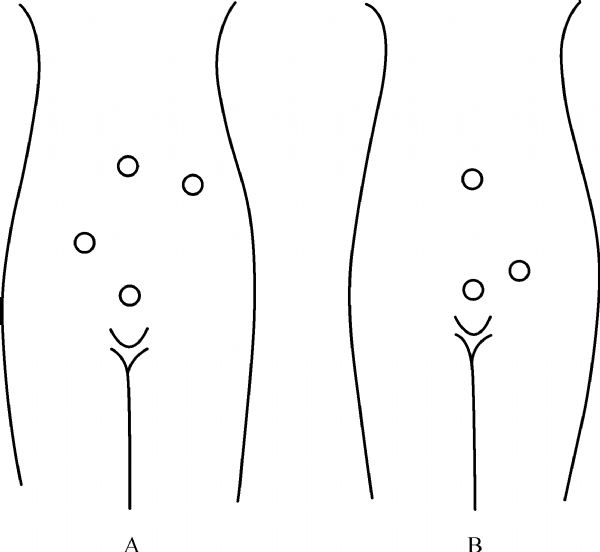

Fertility outcome analysis after modified laparoscopic microsurgical tubal anastomosis
Received date: 08 Jul 2011
Accepted date: 09 Aug 2011
Published date: 05 Sep 2011
Copyright
Modified laparoscopic microsurgical tubal anastomosis is an alternative for microsurgical anastomosis via laparotomy to reverse sterilization in women with renewed child wish. The current study aims to evaluate the fertility outcome after modified laparoscopic microsurgical tubal anastomosis. A retrospective study was performed. Fifty-eight women who underwent modified laparoscopic microsurgical tubal anastomosis were monitored to investigate the fertility outcome and characteristics of this new technology. Of the 58 patients, the cumulative pregnancy rate (PR) in the 42 patients with follow-up data was 23.8% (10/42), 57.1% (24/42), 66.7% (28/42), and 73.8% (31/42) within 6, 12, 24, and 36 months after surgery, respectively. The intrauterine PR was 69.0% (29/42). Two patients (4.8%) had ectopic pregnancies that occurred within 24 months of surgery; three cases ended in spontaneous abortion. The delivery rate was 83.9% (26/31). The length of operating time was 1.2±0.3 h, with a range of 1.0–2.5 h (60–145 min), and the mean time was approximately 75 min. The blood loss was relatively small, between 10 and 50 ml with an average amount of 22 ml. Thus, the modified laparoscopic tubal anastomosis is a highly successful procedure and a viable alternative to open abdominal microsurgical approaches. Compared with the traditional laparoscopic tubal sterilization reversal, this modified approach has three advantages: (1) less invasive approach via a trocar reduction; (2) remodeling of tube is better performing tied together after 3–4 sutures; and (3) faster operating time.

Key words: modified laparoscopy; tubal anastomosis; microsurgery
Jihui Ai , Pei Zhang , Lei Jin , Yufeng Li , Jing Yue , Ding Ma , Hanwang Zhang . Fertility outcome analysis after modified laparoscopic microsurgical tubal anastomosis[J]. Frontiers of Medicine, 2011 , 5(3) : 310 -314 . DOI: 10.1007/s11684-011-0152-8
| 1 |
Kim SH, Shin CJ, Kim JG, Moon SY, Lee JY, Chang YS. Microsurgical reversal of tubal sterilization: a report on 1118 cases. Fertil Steril 1997; 68(5): 865-870
|
| 2 |
Yoon TK, Sung HR, Cha SH, Lee CN, Cha KY. Fertility outcome after laparoscopic microsurgical tubal anastomosis. Fertil Steril 1997; 67(1): 18-22
|
| 3 |
Koh CH, Janik GM, Sutton C. Laparoscopic microsurgery: current and future status. Curr Opin Obstet Gynecol 1999; 11(4): 401-407
|
| 4 |
Yoon TK, Sung HR, Kang HG, Cha SH, Lee CN, Cha KY. Laparoscopic tubal anastomosis: fertility outcome in 202 cases. Fertil Steril 1999; 72(6): 1121-1126
|
| 5 |
Garcia CR. Oviductal anastomosis procedures. In: Richard RM, Prager DJ. Human sterilization. Springfield, IL: Thomas Charies C. 1972: 116
|
| 6 |
Koh CH, Janik GM. Laparoscopic microsurgical tubal anastomosis: results of 40 consecutive cases. In: Program and Abstracts of the 52nd Annual Meeting of the American Society for Reproductive Medicine. Boston, MA. November 2, 1996
|
| 7 |
Dubuisson JB, Chapron C. Single suture laparoscopic tubal re-anastomosis. Curr Opin Obstet Gynecol 1998; 10(4): 307-313
|
| 8 |
Schepens JJ, Mol BW, Wiegerinck MA, Houterman S, Koks CA. Pregnancy outcomes and prognostic factors from tubal sterilization reversal by sutureless laparoscopical re-anastomosis: a retrospective cohort study. Hum Reprod 2011; 26(2): 354-359
|
| 9 |
Tan HH, Loh SF. Microsurgical reversal of sterilisation — is this still clinically relevant today? Ann Acad Med Singapore 2010; 39(1): 22-26
|
| 10 |
Kaloo P, Cooper M. Fertility outcomes following laparoscopic tubal re-anastomosis post tubal sterilization. Australian New Zealand J Obstet Gynaecol. 2002; 42(3): 256-258
|
| 11 |
Ribeiro SC, Tormena RA, Giribela CG, Izzo CR, Santos NC, Pinotti JA. Laparoscopic tubal anastomosis. Int J Gynaecol Obstet 2004; 84(2): 142-146
|
| 12 |
Dharia Patel SP, Steinkampf MP, Whitten SJ, Malizia BA. Robotic tubal anastomosis: surgical technique and cost effectiveness. Fertil Steril 2008; 90(4): 1175-1179
|
| 13 |
Falcone T, Goldberg JM, Margossian H, Stevens L. Robotic-assisted laparoscopic microsurgical tubal anastomosis: a human pilot study. Fertil Steril 2000; 73(5): 1040-1042
|
/
| 〈 |
|
〉 |